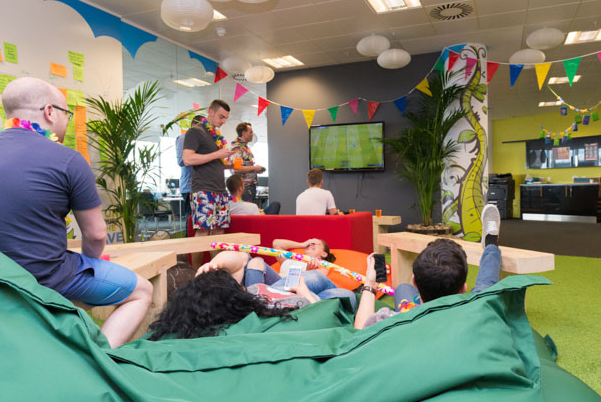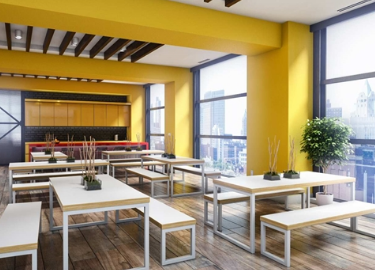You only have to look at TV or the movies to see people are obsessed with what the future holds. Whether that be a future where technological advances such as self tying shoelaces or hoverboards to make our lives easier, or a more dystopian vision where the robots have taken control.
The world of work plays a huge part in this vision and everyone seems to have a theory about what that future looks like. From a future where there are no jobs at all to one where we have multiple careers over our lifetime. And whilst we can’t say for certain what the future will hold, we can say the technological advancements of the last 25 years have been breathtaking. Technologies such as the internet, email and smartphones have revolutionised the way we live and work.
Moving to a new workplace
When you think about the traditional workplace most people will start to think about dull meeting rooms, walled cubicles, grey decor and uncomfortable office chairs. But there has been a shift over the last few years. Many people will have seen pictures of ‘cool’ offices at companies such as Google, Facebook and Airbnb with their relaxation rooms, canteen areas, beanbags, sleep pods and even slides.
.
Unconventional offices are becoming more commonplace with spaces such as BrightHR’s 50ft astroturfed Jack and the Beanstalk themed collaborative space, complete with benches and sofas, as well as a ping pong table, games consoles and a 5 a side football goal. Whatever you think of all these features there’s no denying workplaces are changing. Whilst many businesses won’t go as far as putting a slide in their office, there are a number of benefits in making your office furniture more comfortable, more attractive and in bringing it into the modern, changing world.
Attracting and retaining staff in the internet era.
The digital age has changed the way we communicate with each other and has given us more information than ever before.
Employees now have the ability to look online to see what jobs are available on the market. By searching for jobs anonymously - being able to see what salaries companies are offering and even being able to review the culture of businesses - the balance of power between employee and employer has shifted.
Less than twenty years ago, if an employee was interested in getting a new job they’d need to be seriously committed to putting their head above the parapet. They’d have to speak to a specialist recruitment consultant who recruited for their field of work. Often this person would know their boss! This has changed. People now ‘shop’ for employment from their office tables, in a similar way they’d shop for a consumer brand. Employers can therefore learn a lot from brand-led organisations.
When it comes to jobs we are now able to find out much more about a company. We can find out what it’s like to work there through sites like Glassdoor, what the inside of the workplace look like through virtual tours, what the culture is like through their social media channels, what salaries are on offer through job sites and who works there through LinkedIn. This information is powerful and employees can constantly evaluate their own job and company cultures against what they see online. And if they aren’t happy or see something better, whether that be due to salary, culture, environment, or any number of reasons, they can apply easily, even though they weren't ‘actively’ looking.
The mobility of the modern workforce is demonstrated by trends showing employee longevity within companies is decreasing. In part, this is because employees know how easy it is for them to find a new role. Millennials are the first generation to being to take advantage of online jobs boards and to have this advantage over their employers.
Recruitment and HR software firms are developing algorithms designed to help employers find potential employees who aren’t looking for a new role. This algorithmically automated head hunting technology could potentially mean the balance of power will flow back towards the employer. However at the moment this technology is still in its infancy.
In this ‘new world’, employers need to take a step back to consider how they perceive their own employees and how their employees perceive them. Those employers who don’t rethink their changing relationship with their team may find themselves starting to miss out on recruiting the best talent.
And it’s not just a case that they may fail to attract the best talent. There are huge costs associated with recruiting any new member of staff. If a business can’t keep new team members for long the impact on productivity can quickly become detrimental to long term viability.
In the same way a consumer brand has to create the often tacit reasons for a consumer to go back to a product time and time again, employers have to show their employees and potential employees the benefits of working for them. Employers need to make employees love working for them.
The way a workplace looks can play a big part in terms of this employee evaluation and it’s therefore important for employers to create an environment where people want to work. But you don’t need to go as far as having a table tennis table or a slide in your office however creating break out areas, relaxation spaces, comfy, modern meeting rooms and ergonomic office chairs can make your office a far more attractive place to work. This will not only help retain staff but will ultimately mean less money is spent on recruitment.

Increasing productivity
We seem to have stuck with the belief that the longer you work the more you’ll get done. But is this correct? After all employees can sit at their desks for 8 hours straight but that doesn't mean they’re being productive, it can actually be counter productive. Everyone must have had that mental block where your brain just wasn't functioning and you needed to step away from the screen for a few minutes to clear your mind before you got back to the work. So if you want your employees to be productive it is essential for them to take breaks.
But does your workplace give people the space or facilities to step away from the screen and find an area to chill out, to take five minutes away or to read a chapter of a book in their downtime? By creating these sort of relaxation spaces, or informal meeting areas, you not only encourage your staff to take a break but you also promote team communication, collaboration and bonding. Not bad for a few comfy chairs.
And whilst in the past if an employee didn’t like their job they would probably sit on their desk chairs and suffer in silence, hoping everything would sort itself out. Often these employees would demotivate everyone around them. Long gone are the days where employers can expect an employee to turn up and be thankful for having a job. If an employee doesn’t seem that engaged in their work, expect them to be partially or wholly committed to finding new employment.
Disengaged employees are potentially some of the most disruptive members of the team and a real life drain to a business's productivity. But with a few simple tweaks to a workplace businesses can do something about this!
Improving health and reducing absence
Before email and smartphones even the most stressful jobs largely ceased when the employee left their desk. In the modern world everyone can be sat at home - during the time they’re supposed to be relaxing - answering emails. Even when on social media employees have to be careful about how to portray themselves and how it may be viewed by their employer. This ‘always on’ lifestyle is more stressful than ever before.
Stress and associated illnesses can have a huge impact on business. There’s the lost productivity, increased workload, the time it takes to get cover in and to train them, and that’s not to mention the additional costs. It is important for all companies to monitor absence as closely as possible to uncover any underlying problems and put measures in place to prevent, or even reduce this type of absence. After all you want as many of your staff in work as possible.
Your
office furniture can really help when it comes to improving the health of the office and reducing the level of absence. Relaxation spaces encourage breaks and can help reduce stress, which has been shown as one of the biggest causes of both short-term and long-term workplace absence. Back pain is also one of the main causes of absence but by providing ergonomic chairs you can reduce effects to your business.
This blurring of the boundaries between work life and home life needs to be continually considered by employers. Overcoming the impact of technology and the changing relationship with work involves a number of different strategies. These strategies include focusing on culture, benefits and perks, however carefully crafting the workplace can be a hugely beneficial way to improve the work life of your employees. By improving your employees work life you’ll benefit from reduced absence rates, increased productivity whilst also reducing the cost of employee churn.
Although employers are seeing the benefits of creating appealing workplaces which facilitate forward looking corporate cultures, there is still a way to go in measuring the impact and benefits of these differing strategies. For example monitoring sickness trends, employee engagement rates, staff churn rates and associated people costs. It’s only through proper recording, monitoring and managing that businesses can really begin take control, benefit and optimise their workplaces and cultures, thereby increasing staff productivity.
If you recognise your business isn’t ready for your employees changing relationship with work, or you find yourself losing your employees to your competitors, what are you going to do to make your business’ workplace and corporate culture more suitable for the new workforce? And what people management processes and systems are you going to put in place to demonstrate the success the changes you implement?
As you can see the office furniture shouldn’t be an afterthought and it can bring with it a host of benefits to your business, not just making it look better.
Guest Post: